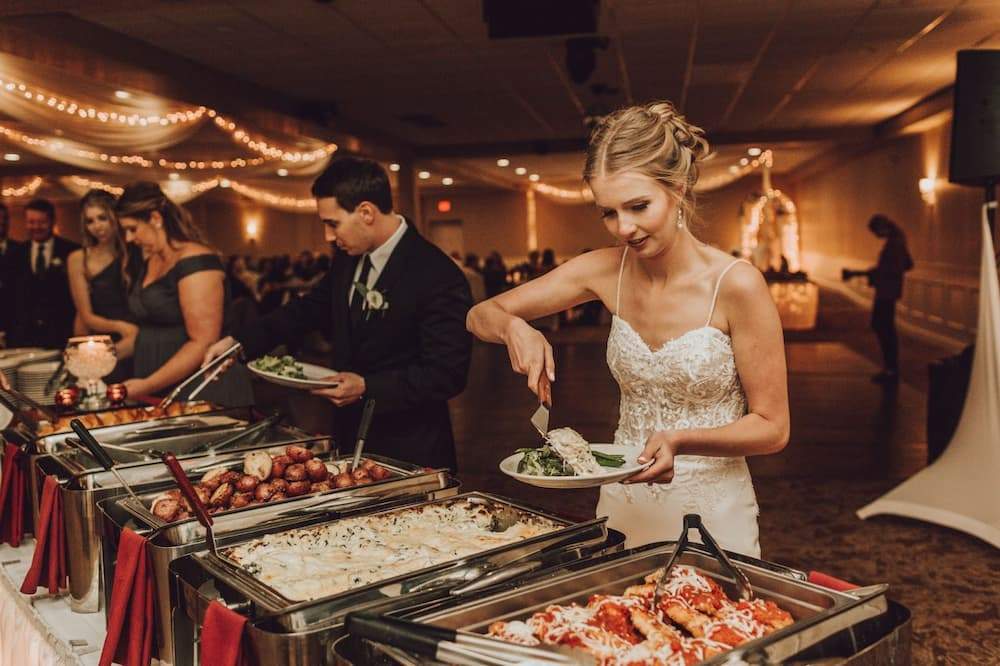
Creative Wedding Food Ideas: Grazing Tables & More: Complete Guide
What's in This Article
- The Allure of Grazing Tables
- Unique Appetizers to Impress
- Elegant Main Courses for a Sophisticated Affair
- Decadent Desserts to End on a Sweet Note
- Beverage Options and Signature Cocktails
- Catering Styles and Service Options
- Dietary Considerations and Inclusive Menu Planning
- Seasonal Wedding Food Ideas
- Budget-Friendly Food Options That Impress
- Final Thoughts: Creating Your Perfect Wedding Menu
- Frequently Asked Questions
Planning a wedding involves countless decisions, but one of the most crucial is the food. Wedding food ideas can set the tone for your entire event, making it memorable for all the right reasons. From grazing tables to unique appetizers, the options are endless and the choices you make will reflect your personal style and taste.
In this comprehensive guide, we'll explore creative wedding food ideas that will delight your guests and make your special day unforgettable. Whether you're considering elegant main courses or trendy grazing tables, we've got you covered with expert advice and inspiration to help you create a culinary experience that your guests will be talking about long after the celebration ends.
The food at your wedding is more than just sustenance—it's an opportunity to tell your story as a couple, to showcase your cultural heritage, and to create moments of joy and connection among your loved ones. Let's dive into the world of culinary inspiration and discover how to create a wedding menu that perfectly captures the essence of your celebration.
Today's couples are moving beyond traditional wedding catering and embracing innovative concepts that reflect their personal tastes. With options ranging from interactive food stations to personalized tasting menus, the possibilities for creating a memorable dining experience are virtually limitless. As we explore these creative wedding food ideas, you'll discover how to infuse your personality into every bite and sip served at your reception.
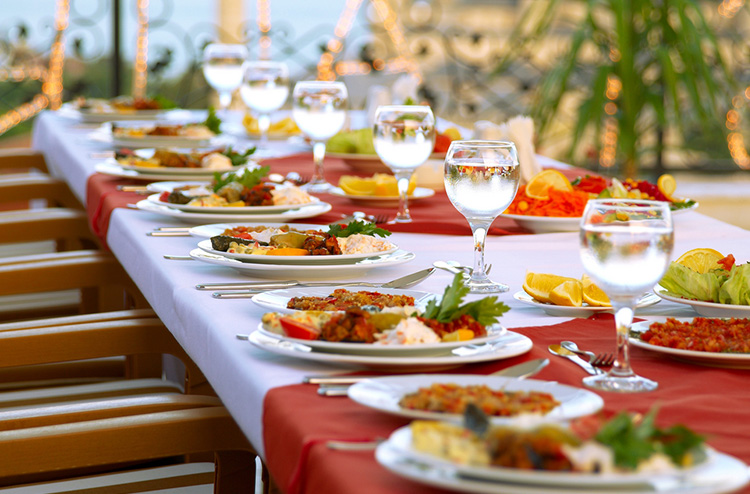
A beautifully arranged wedding reception showcasing diverse culinary offerings
The Allure of Grazing Tables
Grazing tables have become a popular choice for weddings, offering a visually stunning and interactive dining experience. These tables are laden with an array of snacks, from cheeses and cured meats to fresh fruits and nuts, creating a feast for both the eyes and the palate.
The beauty of grazing tables lies in their versatility and ability to cater to diverse tastes and dietary needs. They encourage guests to mingle and enjoy a variety of flavors at their own pace, making them a perfect fit for both casual and formal weddings. A well-designed grazing table can serve as both a culinary delight and a decorative focal point for your reception.
In recent years, grazing tables have evolved from simple cheese and charcuterie boards to elaborate displays that tell a story and reflect the couple's journey. Many couples are now incorporating elements of their first date or favorite travel destinations into their grazing table design, adding a personal touch that resonates with their guests.
What makes grazing tables particularly appealing for weddings is their ability to accommodate various scheduling needs. They can serve as pre-ceremony refreshments, cocktail hour sustenance, or even late-night snacks. This flexibility allows couples to customize their food service timeline while ensuring guests always have delicious options available.
Creating the Perfect Grazing Table
To create a perfect grazing table, start with a selection of high-quality cheeses and cured meats. Include a variety of textures and flavors, from soft brie and creamy goat cheese to aged cheddar and bold blue cheese. For meats, consider prosciutto, salami, and chorizo to provide different taste experiences.
Add a variety of fresh fruits, such as grapes, berries, and sliced figs, to provide a sweet contrast to the savory elements. Nuts and olives can add texture and depth, while artisan breads and crackers offer a satisfying crunch. Consider including dips like hummus, tapenade, or whipped feta for added flavor.
Arrange these elements artfully on a large table, using different heights and textures to create visual interest. Incorporate fresh herbs and edible flowers not only for their beauty but also for their aromatic qualities that enhance the sensory experience. Use wooden boards, marble slabs, and ceramic dishes of varying sizes to create a dynamic and inviting display.
Remember to consider the flow of traffic around your grazing table. Ensure there's enough space for guests to access the table from multiple sides, and provide small plates and napkins for ease of serving. With thoughtful planning and creative presentation, your grazing table will be a highlight of your reception.
Working with an experienced caterer can elevate your grazing table to new heights. Professional food stylists understand how to create balanced compositions that maintain both aesthetic appeal and practical functionality throughout your event. They can also ensure proper food safety with appropriate temperature control and regular refreshing of items that might wilt or dry out over time.
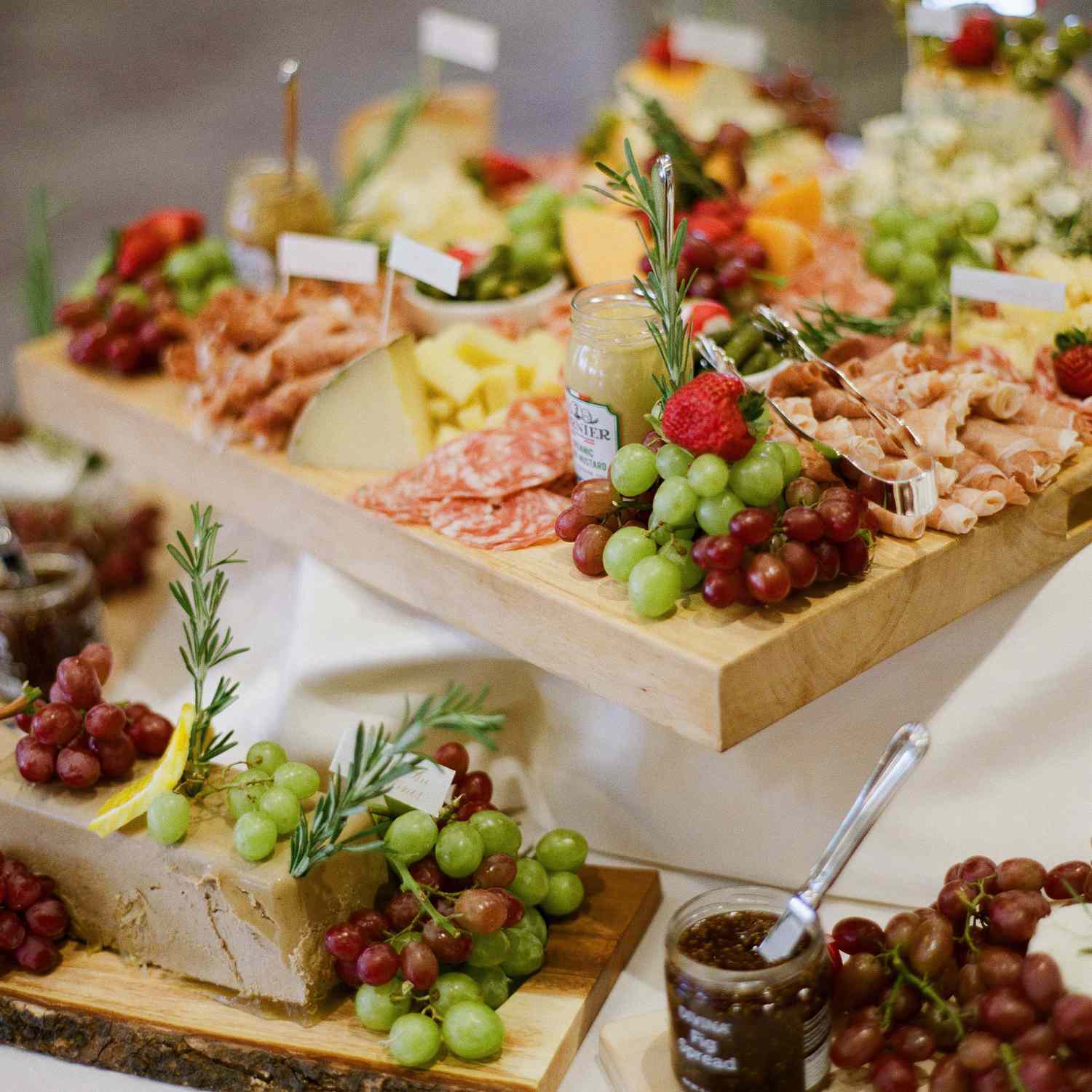
Curated selection of fine cheeses with proper labeling for an enhanced grazing experience
Essential Components of Luxury Grazing Tables
The most memorable grazing tables feature a thoughtful selection of components that work together harmoniously. Begin with a foundation of premium charcuterie, including paper-thin slices of prosciutto di Parma, Spanish chorizo, soppressata, and other artisanal cured meats. These should be arranged in loose folds rather than stacked flat to create dimension and make them easier for guests to take.
For the cheese selection, aim for a balance of milk types (cow, goat, sheep), textures (soft, semi-soft, firm, hard), and flavor profiles (mild, medium, bold). Professional caterers recommend including at least one familiar crowd-pleaser like aged cheddar alongside more adventurous options such as washed-rind or blue cheeses. Proper labeling with small signs can help guests identify unfamiliar varieties.
Accompaniments are crucial for elevating the grazing experience. Include honey infused with herbs or spices, fig jam, stone fruit preserves, and savory chutneys to complement both the cheeses and meats. Pickled elements like cornichons, marinated olives, and quick-pickled vegetables add acidity that cuts through rich flavors. For breadstuffs, offer variety through sliced baguettes, seeded crackers, herbed lavosh, and grissini breadsticks.
Fresh produce adds color, texture, and nutritional balance to the display. Seasonal fruits like fresh berries, sliced pears, and grapes provide sweetness and visual appeal. Vegetables can include endive leaves for scooping, colorful bell pepper strips, and cherry tomatoes. For an additional luxury touch, include dried fruits such as apricots, cherries, and figs alongside premium nuts like Marcona almonds and candied walnuts.
The most impressive grazing tables often include unexpected luxury elements that surprise and delight guests. Consider adding honeycomb frames, truffle-infused honey, caviar with appropriate accompaniments, or even a small station for freshly sliced jamón ibérico with a dedicated server. These special touches create memorable moments and conversation starters among your guests.

Artfully presented cured meats and complementary elements for a luxury grazing experience
Grazing Table Trends for 2025
In 2025, grazing tables are expected to incorporate more plant-based options, reflecting the growing trend towards sustainable and health-conscious eating. Expect to see more vegan cheeses, plant-based charcuterie alternatives, and a wider variety of fresh vegetables. These thoughtful inclusions ensure that guests with various dietary preferences can fully enjoy the grazing experience.
Artisanal and locally sourced products are taking center stage on modern grazing tables. Couples are showcasing cheeses, meats, and preserves from small-batch producers, often with storytelling elements that highlight the craftsmanship behind each item. This focus on provenance not only enhances the dining experience but also supports local food economies.
Interactive elements are becoming increasingly popular additions to grazing tables. Live stations where chefs prepare fresh mozzarella or carve specialty meats add a theatrical dimension to the dining experience. These dynamic components engage guests and create memorable moments throughout the reception.
Aesthetically, 2025 grazing tables are embracing a more refined approach with careful attention to color palettes and styling. Rather than overwhelming displays with too many options, modern grazing tables feature curated selections with intentional color stories that complement the overall wedding design. The 'less is more' philosophy focuses on quality over quantity, with each element chosen for both its flavor profile and visual contribution.
Seasonality is also influencing grazing table design, with couples selecting ingredients that reflect the time of year of their wedding. Summer weddings might feature fresh berries and stone fruits, while autumn celebrations could incorporate roasted root vegetables and warming spiced preserves. This seasonal approach ensures peak flavor and connects the dining experience to the natural world.
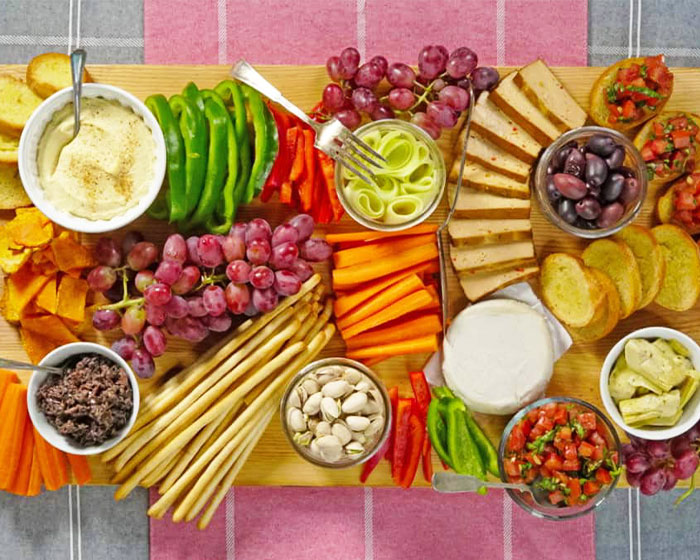
Inclusive plant-based grazing options featuring creative presentations of vegetables and vegan alternatives
Themed Grazing Table Concepts
Themed grazing tables offer a fantastic opportunity to reflect the couple's heritage, favorite cuisines, or travel experiences. Mediterranean-inspired spreads featuring hummus, baba ganoush, dolmas, olives, and feta have become particularly popular for outdoor summer weddings. These vibrant displays evoke coastal vacations and create a relaxed, convivial atmosphere.
For couples with connections to Asian cuisines, contemporary grazing tables might include banh mi ingredients, hand rolls, dumplings, and colorful pickled vegetables. These tables often incorporate beautiful ceramic dishes and bamboo elements to enhance the presentation and create an authentic experience for guests.
American regional themes are gaining traction as couples celebrate their roots or the location of their wedding. Southern-inspired grazing tables might feature pimento cheese, country ham, pickled okra, and biscuits, while New England tables could showcase local seafood, artisanal cheeses, and cranberry preserves. These regional themes create a sense of place and allow couples to share meaningful food traditions with their guests.
Global fusion grazing tables blend elements from multiple cuisines, perfect for couples with diverse cultural backgrounds or those who simply love international flavors. These eclectic displays might pair Mexican street corn salsa with Italian burrata or feature French cheeses alongside Japanese pickles. The key to successful fusion is thoughtful pairing of complementary flavors rather than random combinations.
For couples seeking a truly unique concept, story-based grazing tables that chronicle their relationship have become a creative trend. These displays might feature foods from significant places in their journey—perhaps dishes representing their first date, favorite vacation, or the city where they became engaged. Small signs with anecdotes add context and create conversation starters for guests who may not know the couple's complete story.

Seasonal grazing display incorporating elements from harvest season for a timely wedding celebration
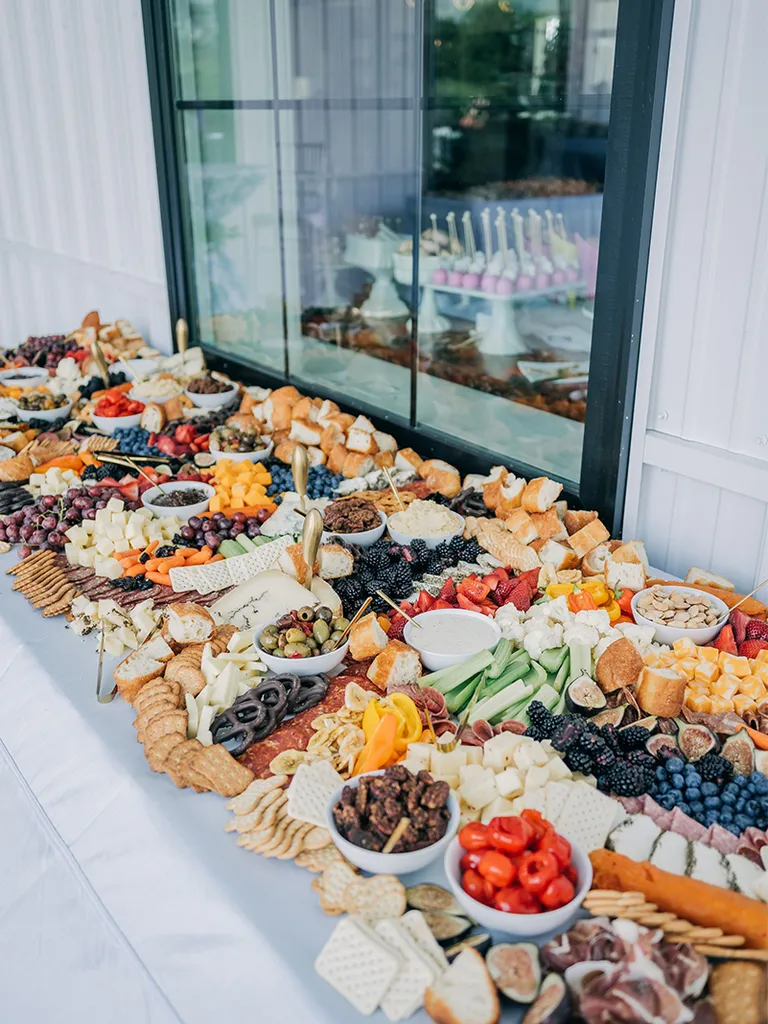
A stunning grazing table featuring a variety of textures and flavors for guests to enjoy
Unique Appetizers to Impress
Appetizers set the stage for the meal to come, and choosing unique options can leave a lasting impression on your guests. From bite-sized delights to innovative flavor combinations, unique appetizers can elevate your wedding menu beyond the ordinary and create a talking point among your guests.
Consider incorporating seasonal ingredients and local flavors to create a menu that is both fresh and memorable. Working with ingredients at their peak ensures optimal flavor and often reduces the environmental impact of your menu. Seasonal appetizers also tell the story of your wedding date, connecting the food experience to the specific time of year you chose to celebrate.
Whether you're hosting a casual outdoor wedding or a formal indoor affair, there's an appetizer approach to suit every style and theme. The presentation of these small bites is just as important as their flavor—consider how they'll be served and consumed in your specific venue and with your particular guest list in mind.
One of the challenges with wedding appetizers is ensuring they're convenient for guests to eat while mingling. The best wedding appetizers can be enjoyed in one or two bites without complicated assembly or messy sauces. Consider how guests will be holding drinks, navigating conversations, and managing their appetizers when making your selections.
Top Unique Appetizer Ideas
Some top unique appetizer ideas include mini sliders with gourmet fillings, such as truffle aioli, caramelized onions, or blue cheese. These hand-held bites offer a satisfying mouthful while remaining elegant and easy to eat. Consider offering a selection of different fillings to cater to various taste preferences among your guests.
For seafood lovers, elevated shrimp cocktails with unexpected twists can refresh a classic. Try serving them with a spicy mango salsa, avocado mousse, or citrus-infused dipping sauce rather than traditional cocktail sauce. The presentation can also be updated—individual shot glasses with the sauce at the bottom and the shrimp perched on the rim create an elegant, modern look.
Vegetarian options such as stuffed mushrooms with herbed goat cheese or caprese skewers with balsamic pearls can cater to diverse dietary preferences while offering sophisticated flavor profiles. Plant-based appetizers have evolved far beyond basic crudités and now include innovative options like watermelon 'tuna' on rice crisps or jackfruit tostadas with pickled vegetables.
For winter weddings, consider warm, comforting appetizers like miniature soup sips served in espresso cups. Butternut squash soup with a hint of maple, french onion with gruyère croutons, or a creamy mushroom bisque can welcome guests and take the chill off a cold day. These can be passed by servers or set up at stations throughout your cocktail area.
Interactive appetizer stations have become increasingly popular, allowing guests to customize their small bites. A build-your-own crostini bar with various spreads, toppings, and garnishes, or a personalized tartare station attended by a chef creates engagement and conversation while offering a unique culinary experience.
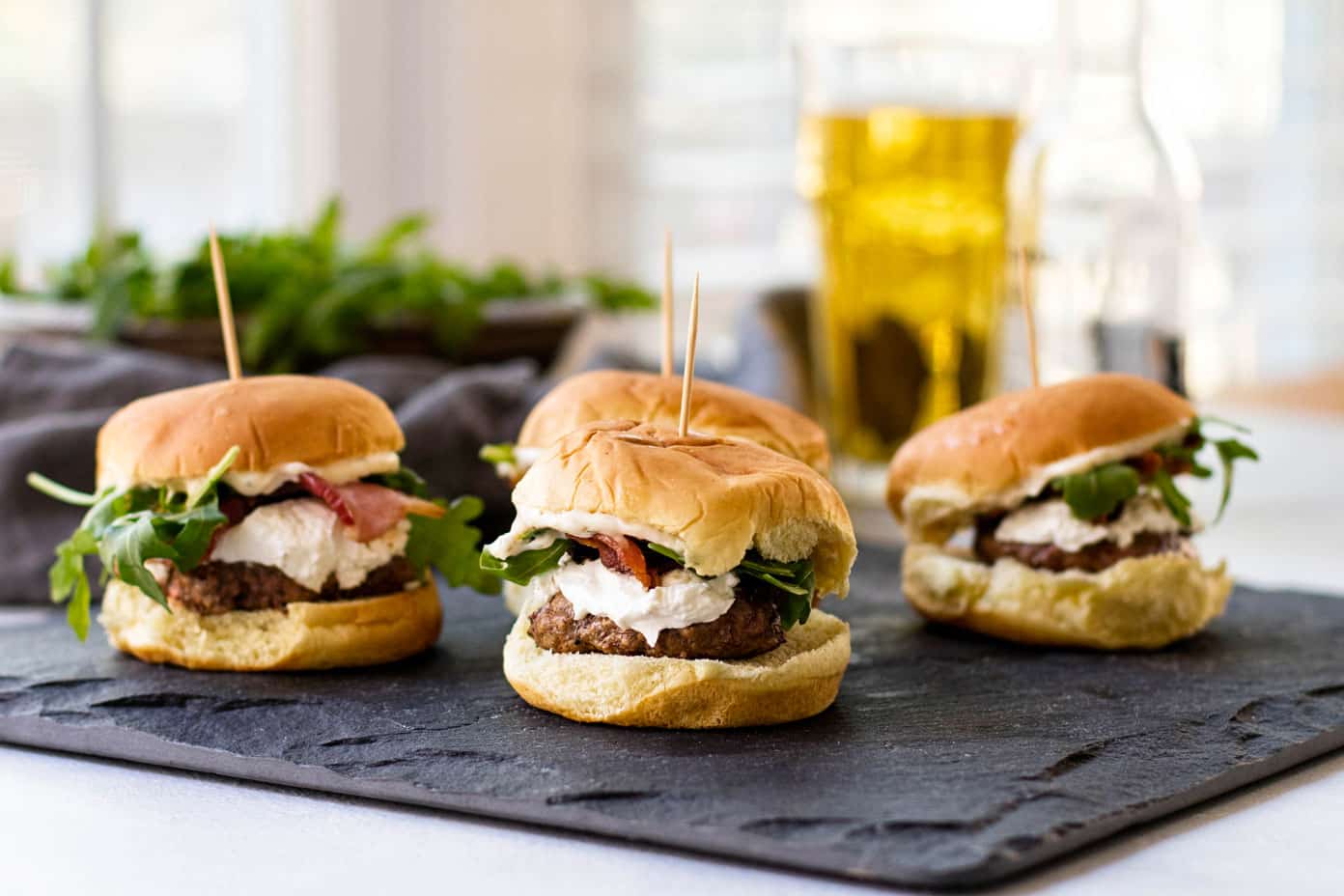
Elevated mini slider appetizers featuring gourmet ingredients and artful presentation
Innovative Seafood Appetizer Presentations
Seafood appetizers offer endless possibilities for creativity and luxury at weddings. Rather than traditional seafood towers, consider modern alternatives like individual seafood spoons featuring a single perfect bite—perhaps a scallop ceviche with citrus and chili, or a spoonful of lobster salad with micro greens. These elegant offerings provide a refined seafood experience without the commitment of a larger portion.
Oysters remain a wedding favorite but have evolved in their presentation. Instead of standard oysters on ice, consider offering them with inventive mignonettes such as champagne-elderflower, cucumber-gin, or strawberry-black pepper. A dedicated oyster bar with a knowledgeable shucker who can explain the varieties adds an educational element to the luxury experience.
Sushi and sashimi presentations have become increasingly artistic at upscale weddings. Hand rolls made to order, sashimi served on illuminated ice blocks, or nigiri with edible flowers and gold leaf create visual impact. For couples concerned about raw fish, consider vegetable-forward sushi with avocado, mango, or pickled vegetables, or cooked options like tempura shrimp or unagi.
Sustainable seafood choices are increasingly important to environmentally conscious couples. Consider featuring lesser-known but sustainable seafood varieties like sea bass ceviche, octopus carpaccio, or smoked trout on buckwheat blinis. Working with your caterer to source responsibly harvested seafood ensures your celebration doesn't come at an environmental cost.
Temperature contrasts create memorable seafood appetizers. Consider pairing chilled seafood with warm elements—perhaps cold poached shrimp with warm corn velouté, or tuna tartare alongside crispy wontons fresh from the fryer. These temperature plays create a dynamic sensory experience and showcase culinary expertise. Remember to complement these innovative presentations with the perfect French 75 cocktail, whose citrus notes wonderfully enhance seafood flavors.
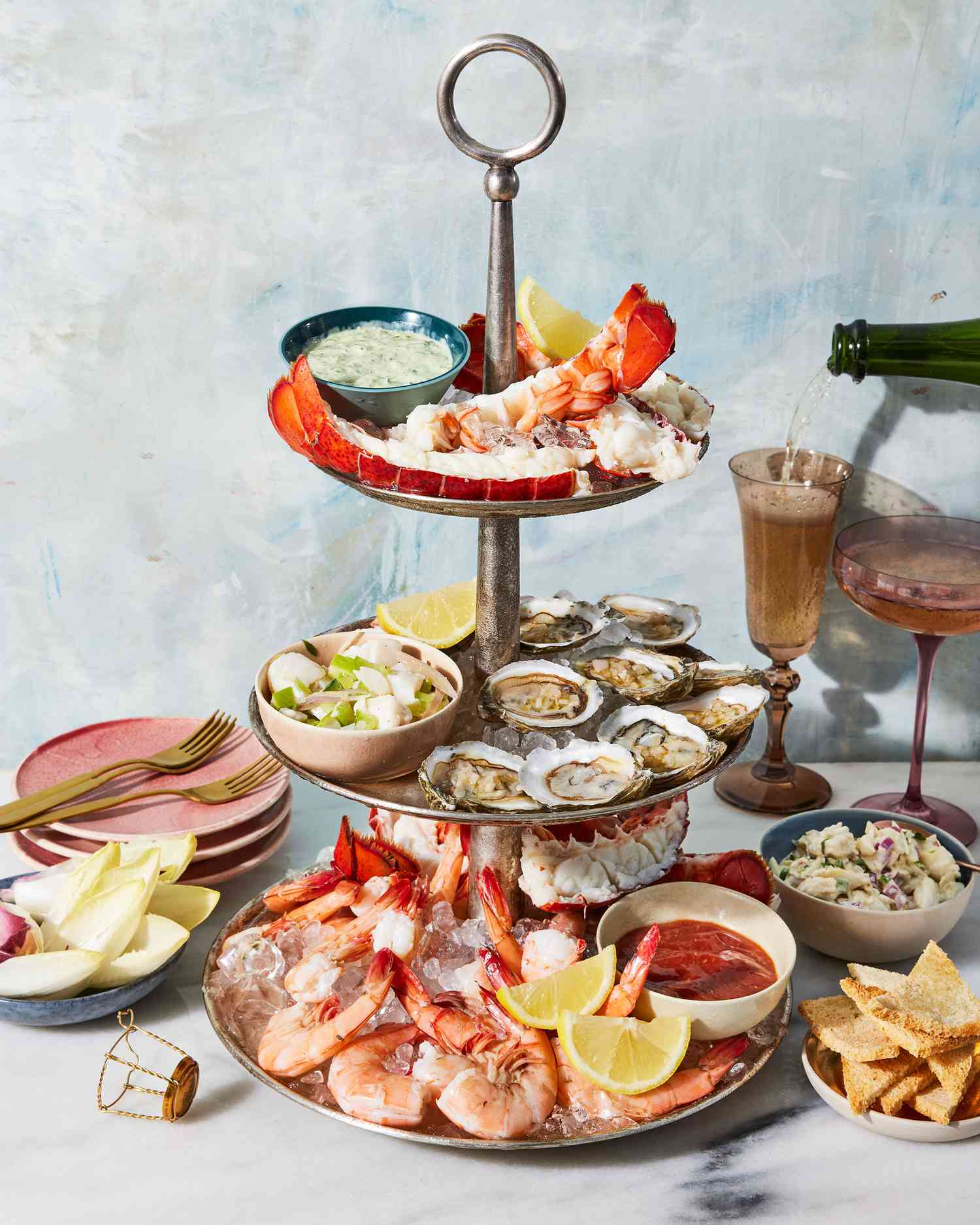
Spectacular seafood tower offering guests a luxurious start to the wedding feast
Incorporating Local Flavors
Incorporating local flavors into your appetizers can add a personal touch to your wedding menu and create a sense of place for your guests. If you're hosting your wedding in a coastal area, consider serving fresh seafood appetizers that highlight the region's bounty, such as mini lobster rolls in New England, crab cakes in Maryland, or ceviche in coastal California.
For a rustic countryside wedding, options like mini beef wellingtons using locally raised beef or goat cheese tarts featuring cheese from nearby farms can reflect the local cuisine while supporting small producers. Working with caterers who have established relationships with local farmers ensures freshness and quality while reducing the carbon footprint of your menu.
Urban weddings can capitalize on the diversity of city neighborhoods and cultural influences. Consider creating an appetizer tour of your city, with each small bite representing a different neighborhood or cultural enclave. This approach not only provides variety but also tells the story of your city and perhaps your relationship within it.
Seasonal produce from farmers' markets can inspire one-of-a-kind appetizers that couldn't be replicated at any other time of year. Spring weddings might feature asparagus spears wrapped in prosciutto or pea and mint crostini, while fall celebrations could offer butternut squash soup shooters or mushroom tartlets featuring foraged varieties.
Traditional regional preparations given modern interpretations create appetizers with both nostalgic appeal and contemporary sophistication. Southern deviled eggs updated with smoked trout and pickled shallots, or New Mexican stuffed peppers with a refined presentation exemplify this approach to honoring local culinary heritage while offering something fresh and unexpected.
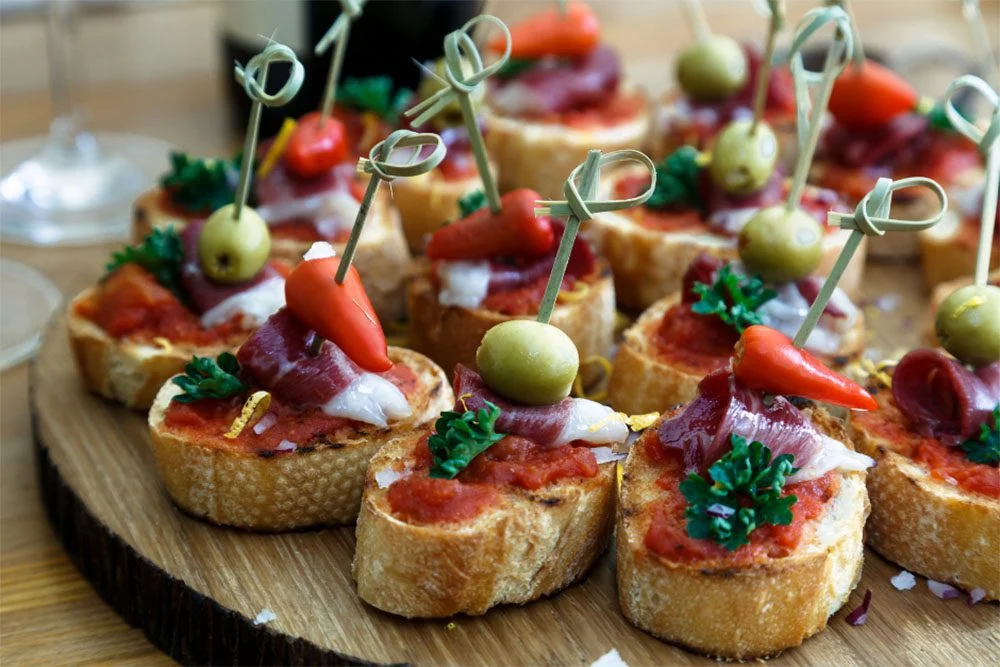
Appetizers showcasing the finest local ingredients from regional producers
Vegan and Allergen-Friendly Appetizer Solutions
Creating inclusive appetizer options ensures all guests can participate fully in your celebration. Modern vegan appetizers go far beyond basic vegetable platters to include innovative options like watermelon 'tuna' poke bowls, mushroom 'calamari' with aioli, or jackfruit sliders that mimic pulled meat textures. These plant-based creations can be so enticing that even omnivorous guests will be drawn to them.
When developing allergen-friendly options, communication with your caterer is essential. Rather than treating allergen-free dishes as an afterthought, incorporate them seamlessly into your appetizer selection. Items like rice paper summer rolls with herbs and vegetables, gluten-free blinis with smoked salmon, or dairy-free stuffed mushrooms can be enjoyed by almost everyone.
Consider developing a comprehensive labeling system for your appetizer selections. Small flags or elegant cards can discreetly indicate which items are vegan, gluten-free, nut-free, or dairy-free. This thoughtful touch allows guests with dietary restrictions to navigate the offerings with confidence and without having to repeatedly query servers.
Working with skilled plant-based chefs can elevate your vegan appetizer game significantly. These specialists understand how to create depth of flavor and satisfying textures without animal products. Their expertise can transform simple ingredients into sophisticated bites that will impress even the most discerning guests.
Remember that accommodating dietary restrictions doesn't mean sacrificing visual appeal or flavor. Some of the most colorful and creative appetizers are naturally plant-based and allergen-friendly. Vibrant beet tartare on gluten-free crackers, rainbow vegetable sushi rolls, or jewel-toned gazpacho shots can be both inclusive and Instagram-worthy additions to your wedding menu.
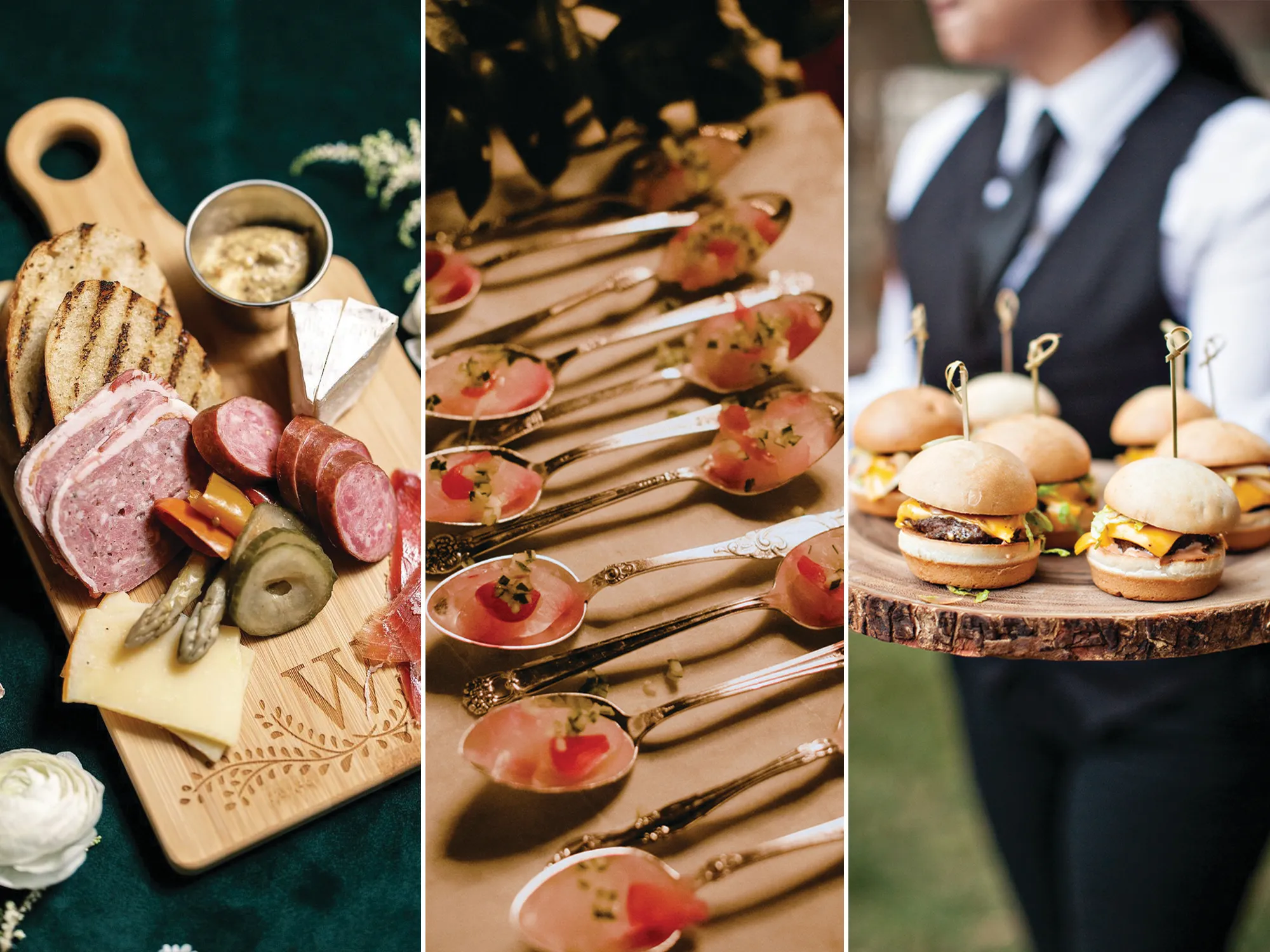
Professional presentation of passed appetizers setting the tone for an upscale wedding reception
Elegant Main Courses for a Sophisticated Affair
For couples planning a sophisticated wedding, elegant main courses are a must. These dishes not only satisfy the palate but also add a touch of luxury to the event. From classic roast chicken to indulgent lobster, the options for elegant main courses are endless and can be tailored to reflect your personal style and the formality of your celebration.
When selecting your main course, consider the overall theme of your wedding and the preferences of your guests. A well-chosen main course should feel cohesive with the rest of your menu and dining experience. The presentation of these dishes is just as important as their flavor—artful plating can elevate even simple ingredients to create a memorable dining experience.
The dining format also influences your main course selections. Plated dinners allow for more complex presentations and temperature-sensitive dishes, while buffet or family-style service requires foods that can hold up well over time. Work closely with your caterer to select dishes that will perform well within your chosen service style.
Seasonal considerations should play a role in your main course selection. Summer weddings might showcase lighter proteins with vibrant produce, while winter celebrations call for heartier, more substantial main courses. Aligning your menu with the season ensures not only the best quality ingredients but also a natural harmony with your overall event.
Classic Elegance with Roast Chicken
Roast chicken is a timeless choice for an elegant main course, beloved for its universal appeal and versatility. Its familiarity makes it approachable for guests of all ages, while skillful preparation and presentation can elevate it to fine dining status. A perfectly roasted chicken with crispy, golden skin and juicy meat demonstrates culinary expertise despite its apparent simplicity.
To elevate this classic dish, consider using heritage or organic birds that offer superior flavor. Preparations that incorporate herb-infused butter under the skin, citrus brining techniques, or aromatic stuffing can transform the humble chicken into a sophisticated entrée. French techniques like ballotine (deboned and stuffed) or galantine (deboned, stuffed, and poached) offer elegant presentations that go beyond basic roasting.
The versatility of chicken allows it to be paired with a variety of sides, from creamy mashed potatoes to seasonal vegetables. Consider creating a signature preparation that reflects your tastes as a couple—perhaps incorporating herbs from your garden or a preparation style from a meaningful cultural tradition. These personal touches make a standard dish uniquely yours.
The presentation of roast chicken can range from rustic to refined, depending on your wedding style. For formal affairs, individual portions plated with artistic sauce work, while family-style service might feature whole birds carved tableside for a theatrical element. Work with your caterer to determine which approach best suits your vision and venue.
Dietary variations on the classic roast chicken can accommodate various needs while maintaining the dish's elegant appeal. Consider offering cornish game hens for smaller portions, or spatchcocked preparations for faster cooking and unique presentation. These variations maintain the essence of the dish while providing flexibility for your particular service needs.

Classic herb-roasted chicken elevated with professional culinary techniques and presentation
Indulgence with Lobster
For a truly indulgent main course, lobster is an excellent choice that instantly communicates luxury and celebration. Its rich flavor and luxurious presentation make it a standout dish for any wedding, particularly formal evening affairs. While traditionally associated with coastal weddings, modern logistics make it possible to serve fresh lobster at venues around the country.
Classic preparations like butter-poached lobster tail showcase the natural sweetness of the meat, while allowing skilled chefs to demonstrate their precision. For a more contemporary approach, consider lobster paired with unexpected elements like vanilla bean beurre blanc, citrus and chili, or subtle hints of curry. These modern interpretations respect the main ingredient while offering guests a surprising and memorable flavor experience.
Serving techniques for lobster vary widely and can be adapted to your wedding style. Individual butter-poached tails make for precise plated service, while dramatic whole lobsters can create a memorable presentation for smaller, more intimate gatherings. Some couples opt for lobster as part of a surf and turf offering, pairing it with a premium beef option to satisfy diverse preferences.
Wine pairings are essential to consider when serving lobster. A crisp Chablis, unoaked Chardonnay, or even a light Champagne can complement lobster beautifully without overwhelming its delicate flavor. Work with a sommelier to select the perfect wine that bridges your lobster preparation with other elements of your meal.
While lobster is indeed a luxury ingredient, there are approaches that can make it more accessible for larger weddings. Lobster risotto, lobster mac and cheese with truffle, or lobster incorporated into pasta dishes allow the flavor and luxury associations to extend further. These preparations maintain the indulgent experience while working within various budget parameters.
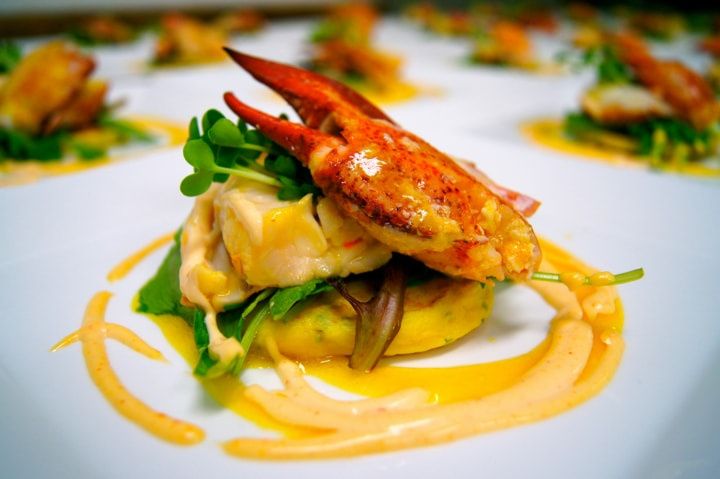
Decadent lobster dish representing the height of wedding culinary luxury
Vegetarian Gourmet Options
Gone are the days when vegetarian wedding options were an afterthought. Today's vegetarian main courses can be the stars of the culinary show, offering sophisticated flavors and artistic presentations that appeal to all guests. Moving beyond basic pasta or stuffed peppers, contemporary vegetarian wedding mains embrace global flavors and innovative techniques.
Seasonal vegetable tasting plates showcase the best produce available during your wedding season, presented with the same attention to detail as premium protein dishes. Summer weddings might feature heirloom tomato tarts with whipped ricotta and micro basil, while autumn celebrations could offer butternut squash wellington with mushroom duxelles and flaky pastry. These thoughtful creations celebrate vegetables as worthy centerpieces rather than mere sides.
Ancient grains and heirloom legumes provide substance and protein in elegant vegetarian mains. Farro risotto with roasted seasonal vegetables and truffle, quinoa-stuffed acorn squash with pomegranate and pistachio, or beluga lentil cakes with saffron aioli offer satisfying options that won't leave guests hungry. These hearty bases can be dressed up with microgreens, edible flowers, or delicate herb oils for a fine dining presentation.
Global vegetarian traditions provide rich inspiration for wedding mains that go beyond Western conventions. Consider Indian thalis with multiple small dishes, Mediterranean platters with house-made falafel and mezze, or Japanese-inspired bento boxes with seasonal vegetables in various preparations. These culturally-rooted options offer depth of flavor and interesting dining experiences for your guests.
When planning vegetarian options, consider not just those who follow vegetarian diets but also how these dishes might appeal to all your guests. The most successful vegetarian wedding mains are those chosen because they're delicious in their own right, not simply as alternatives to meat. This mindset ensures your vegetarian guests feel equally valued in your culinary vision.
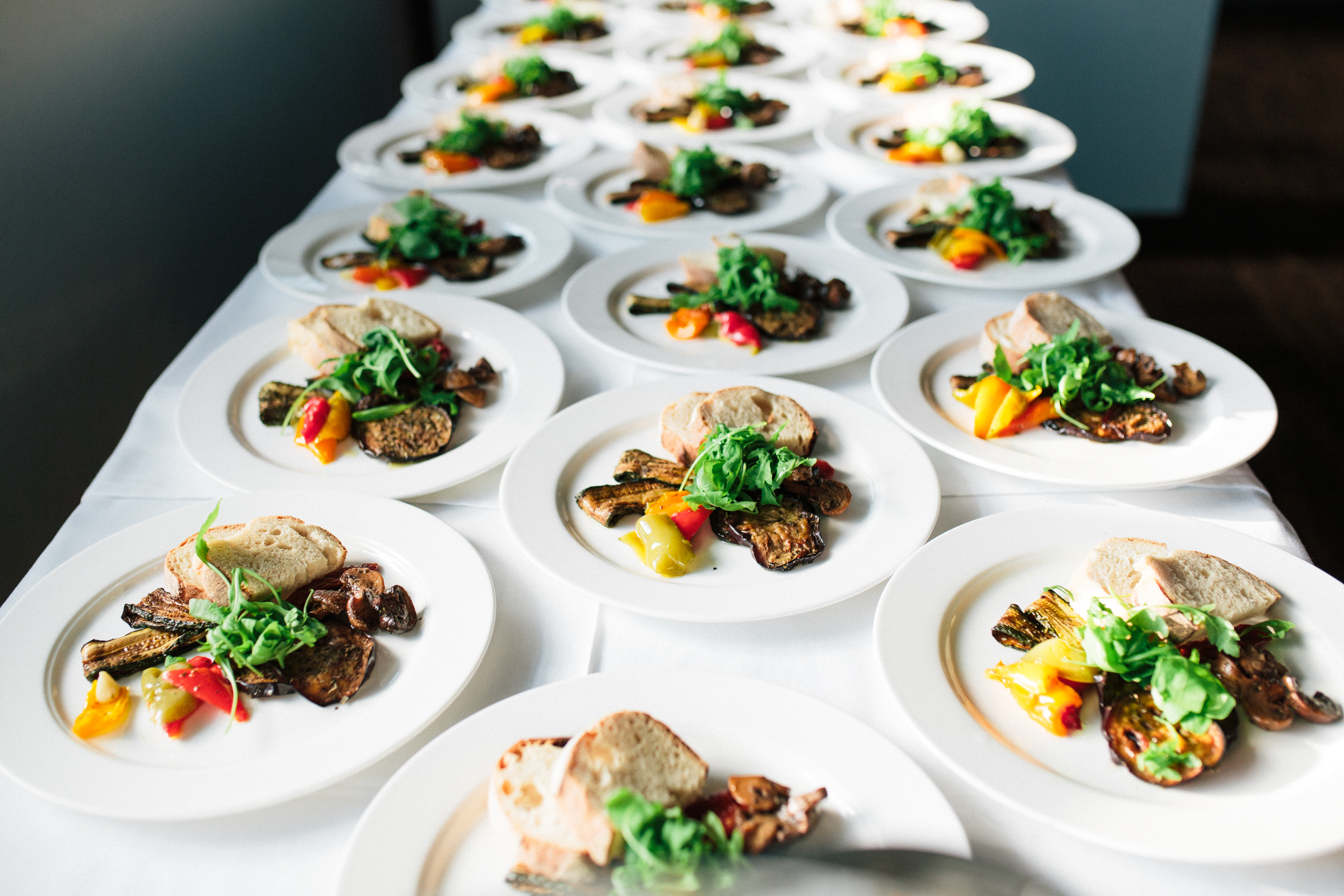
Thoughtfully crafted vegetarian entree showcasing the versatility of plant-based wedding cuisine

Meticulously plated main course exemplifying fine dining presentation at a luxury wedding
Decadent Desserts to End on a Sweet Note
No wedding menu is complete without a selection of decadent desserts. These sweet treats provide the perfect ending to a memorable meal, leaving your guests with a lasting impression. From classic wedding cakes to innovative dessert bars, the options are endless and offer numerous opportunities to showcase your personality as a couple.
When planning your dessert menu, consider both the practical aspects—such as how the desserts will be served and consumed—and the aesthetic elements that will make them visually stunning. The most successful wedding desserts satisfy both the palate and the eye, becoming part of your event's overall design story.
The timing of dessert service impacts your selections. Will desserts be served while guests are seated, presented at a designated dessert station, or offered as guests mingle on the dance floor? Each approach calls for different types of desserts that can be enjoyed in that particular setting and maintain their quality throughout your event.
Consider, too, how your desserts might complement other elements of your reception, such as the coffee service or after-dinner drinks. Thoughtful pairings can elevate both components and create a cohesive culinary experience from start to finish. These final sweet moments of your reception deserve the same careful planning as every other aspect of your wedding menu.
Classic Wedding Cakes with a Twist
Classic wedding cakes remain a popular choice, but modern couples are adding their own twists to this tradition. Consider incorporating unique flavors, such as lavender, matcha, black sesame, or even unexpected savory notes like rosemary or olive oil. These distinctive flavor profiles can reflect your personal tastes while surprising and delighting your guests with something beyond the expected vanilla or chocolate.
For a visually stunning presentation, consider alternatives to traditional fondant-covered cakes. Naked or semi-naked cakes that expose layers of cake and filling offer a rustic yet elegant aesthetic perfect for garden or countryside weddings. Textured buttercream techniques like spatula painting, watercolor effects, or concrete-inspired finishes provide contemporary visual interest without the sweetness of fondant.
Decorative elements are evolving beyond standard sugar flowers to include more personal and unexpected adornments. Fresh, edible flowers and herbs create a garden-fresh appearance, while painted details using food coloring can transform a cake into a canvas for artistic expression. Some couples opt for metallic elements like gold leaf or hand-painted metallic designs that coordinate with other wedding decor elements.
Alternative structures are reimagining what a wedding cake can be. Geometric designs with sharp angles and modern silhouettes appeal to architecturally-minded couples, while suspended or gravity-defying cake elements create conversation-starting centerpieces. For couples seeking something truly unique, cakes inspired by meaningful locations or objects—perhaps modeled after your first-date venue or shared hobby—offer one-of-a-kind dessert experiences.
To accommodate dietary needs without sacrificing the traditional cake-cutting moment, consider a small cutting cake accompanied by individually portioned desserts. This approach allows you to maintain the symbolic cake ceremony while ensuring all guests can enjoy dessert regardless of dietary restrictions. Your cake designer can create cohesive designs that visually connect all elements of your dessert presentation.

Modern wedding cake design incorporating fresh, edible flowers and contemporary styling
Innovative Dessert Bars
Dessert bars offer a fun and interactive way for guests to enjoy a variety of sweet treats. Unlike a single cake that provides one flavor experience, dessert bars can accommodate diverse preferences and create a sense of exploration and discovery. These installations have evolved from simple cookie displays to elaborate, themed dessert experiences that serve as both refreshment and entertainment.
Consider setting up a station with mini desserts, such as macarons in unexpected flavors, handcrafted chocolate bonbons with artistic designs, or tiny tarts featuring seasonal fruits. These bite-sized indulgences allow guests to sample multiple offerings without feeling overwhelmed by large portions. For visual impact, arrange these miniatures on tiered displays, illuminated ice sculptures, or custom-built structures that reflect your wedding theme.
For a unique twist, include interactive elements like a DIY s'mores bar with gourmet marshmallows, artisanal chocolate selections, and unexpected graham cracker flavors. Flame stations attended by staff ensure safety while adding theatrical flair. Other interactive options include nitrogen ice cream stations where guests can watch their dessert freeze instantly, or donut walls where fresh pastries are displayed vertically for a contemporary presentation.
Dessert bars can also tell a story about your relationship or heritage. Consider featuring family recipe cookies with framed recipe cards explaining their significance, or desserts that represent places you've traveled together or cultural traditions that are meaningful to your families. These narrative elements add depth to the dessert experience and create conversation starters among guests.
To maintain the cake-cutting tradition while embracing the dessert bar concept, many couples opt for a small ceremonial cake accompanied by an abundant dessert display. This hybrid approach satisfies traditional expectations while offering the variety and visual impact of a dessert bar. Work with your baker and event designer to create a cohesive look that ties these elements together visually.

Interactive dessert bar offering guests a personalized sweet ending to the wedding celebration
Chocolate Indulgences
Chocolate deserves special consideration in wedding dessert planning, as its universal appeal and inherent sense of luxury make it a natural fit for celebrations. Beyond basic chocolate cake, consider dedicated chocolate experiences that showcase the complexity and versatility of this beloved ingredient. From single-origin tastings to dramatic chocolate sculptures, there are countless ways to incorporate chocolate into your wedding desserts.
Artisanal chocolate tastings can provide a sophisticated dessert experience for guests with discerning palates. Featuring chocolates with different percentages of cacao or from various growing regions allows guests to appreciate the nuanced flavors similar to wine tasting. Pair these chocolates with complementary wines, spirits, or coffee for a complete sensory experience that extends the dessert course into a meaningful part of your reception.
Chocolate fountain installations have evolved from their early popularity into more refined presentations. Modern versions feature high-quality couverture chocolate and unexpected dipping items beyond fruit—consider house-made marshmallows, artisanal biscotti, or even salty elements like pretzel rods or potato chips that play with sweet-savory contrast. For a contemporary twist, some couples opt for multiple smaller fountains with different chocolate types—dark, milk, and white—or flavored chocolates infused with spices or liqueurs.
Plated chocolate desserts with tableside elements create memorable moments for seated receptions. Consider warm chocolate cake with molten centers and a server pouring vanilla crème anglaise at the table, or chocolate spheres that melt when hot caramel is poured over them to reveal hidden components inside. These theatrical presentations transform dessert from a simple sweet into an experience guests will remember.
For favors that extend the chocolate experience beyond the reception, consider take-home options like custom-molded chocolates featuring your monogram or wedding date, boxes of truffles with flavors that reference your menu or love story, or hot chocolate mixes with house-made marshmallows for winter weddings. These thoughtful extensions of your dessert service allow guests to continue enjoying your hospitality even after they've returned home.
Beverage Options and Signature Cocktails
The beverage selection at your wedding deserves the same thoughtful consideration as the food menu. From welcome drinks to toast options to after-dinner sips, your beverage choices create numerous touchpoints for guest experience throughout your celebration. A well-planned beverage program complements your cuisine and keeps guests refreshed and engaged.
When designing your wedding beverage menu, consider the flow of your event and how different drinks will serve different moments. Light, refreshing options work well for pre-ceremony and cocktail hour, while more substantial wines pair with dinner, and festive options accompany dancing and celebration. This intentional progression enhances each phase of your reception.
Practical considerations such as venue restrictions, service style, and guest demographics should influence your selections. Some venues limit certain types of alcohol or service methods, while outdoor locations may require special considerations for keeping drinks at proper temperatures. Understanding these parameters early in your planning process helps avoid disappointments or last-minute changes.
Budgeting for beverages typically represents a significant portion of wedding catering costs. Various service models—from full open bar to limited options to cash bar—offer different price points and experiences. Finding the right balance for your particular situation ensures you can provide hospitality that feels generous without exceeding your financial comfort zone.
Creating Memorable Signature Cocktails
Signature cocktails have become a beloved wedding tradition, allowing couples to express their personality through custom drink creations. These special beverages can reflect your taste preferences, honor family traditions, commemorate significant moments in your relationship, or simply provide a delicious welcome for your guests. A thoughtfully designed signature cocktail becomes both a refreshment and a conversation piece.
When developing signature cocktails, consider creating one option that appeals to those who prefer lighter, brighter flavors and another for guests who enjoy more spirit-forward drinks. This balanced approach ensures most guests will find something to enjoy. Work with an experienced mixologist who can help translate your ideas into balanced, appealing drinks that can be efficiently prepared for your guest count.
Naming your signature cocktails adds a personal touch that guests appreciate. Consider names that reference inside jokes, places you've traveled together, your pets, or the story of how you met. Display these names along with brief descriptions on elegant signage or custom printed cocktail napkins for a cohesive presentation that invites guests into your story.
Visual appeal matters significantly for signature cocktails, as they'll likely appear in many of your wedding photos. Consider color coordinating with your wedding palette, using distinctive glassware, or adding garnishes that create visual interest. Elements like edible flowers, colored sugars, smoke infusions, or custom ice cubes with embedded botanicals create Instagram-worthy presentations.
For a truly memorable experience, consider serving a classic Aperol Spritz with a signature twist that makes it uniquely yours. This bright, bubbly Italian cocktail creates a festive atmosphere and photographs beautifully with its vibrant orange hue. The bittersweet flavor profile stimulates the appetite, making it perfect for cocktail hour before your meal service begins.

Bespoke cocktail station featuring the couple's signature drinks and professional mixologists
Wine and Beverage Selections
Wine selection for weddings requires balancing broad appeal with quality and complementing your menu. Rather than offering extensive options, focus on selecting 1-2 white wines and 1-2 red wines that pair well with your food offerings. For white wines, unoaked Chardonnay and Sauvignon Blanc offer versatility that works with many dishes, while Pinot Noir and Merlot provide accessible red options that won't overwhelm lighter courses.
Sparkling wines create celebratory moments throughout your wedding day. While Champagne is traditional for toasts, consider other high-quality sparkling options like Prosecco, Cava, or American sparkling wines that offer excellent value. For a luxurious touch without the full Champagne price tag, consider serving Crémant from various French regions—these traditional-method sparklers deliver impressive quality at approachable prices.
Non-alcoholic beverage options deserve the same creative attention as cocktails and wines. Today's sophisticated non-alcoholic selections go far beyond soda and club soda to include alcohol-free spirits, botanical infusions, and craft mocktails with complex flavor profiles. Ensuring these options are presented with the same care as alcoholic beverages demonstrates thoughtfulness toward guests who aren't consuming alcohol.
Seasonal influences can guide your beverage selections just as they do your menu. Summer weddings might feature rosé wines, spritz-style cocktails, or fruit-infused water stations, while winter celebrations could include mulled wine, apple cider (spiked or non-alcoholic), or rich red wines. These seasonal touches create cohesion between your beverages and the overall experience of your event.
Consider how your beverages will be served throughout the event. Table service of wine during dinner provides a formal experience, while strategically placed bars for cocktail hour keep lines manageable. Some couples opt for satellite bars featuring different specialties—perhaps a whiskey bar in one area and a bubbly bar in another—to distribute guests and create different experience zones throughout their reception space.
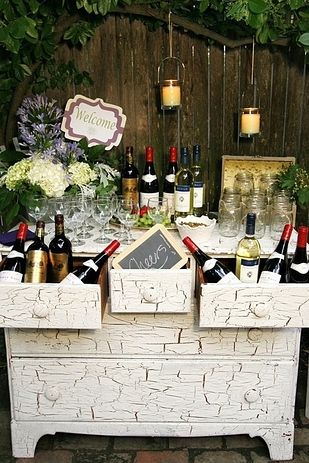
Curated wine selection with expert pairing suggestions enhancing the dining experience
Catering Styles and Service Options
The style of service you choose for your wedding significantly impacts the guest experience, budget, and overall ambiance of your reception. From formal plated dinners to interactive food stations, each service style has distinct advantages and considerations. Understanding these differences helps you select the approach that best aligns with your vision, venue constraints, and guest expectations.
Beyond the food itself, the service style influences the rhythm and flow of your reception. Plated service creates a structured, synchronized dining experience, while stations and buffets allow for more movement and mingling. Your choice should reflect not just culinary preferences but also the social experience you want to create for your celebration.
Practical considerations like your venue's kitchen capabilities, your guest count, and your timeline also influence which service style makes sense for your particular wedding. Some historic venues have limited on-site cooking facilities that may restrict certain service styles, while very large guest counts might make some approaches logistically challenging or prohibitively expensive.
The staffing implications of different service styles affect both the guest experience and your budget. Plated service requires more servers but fewer culinary staff, while station-based approaches may need more chefs but fewer servers. Understanding these tradeoffs helps you allocate your catering budget effectively while ensuring smooth execution.
Elegant Plated Service
Plated service remains the gold standard for formal wedding receptions, creating a cohesive, synchronized dining experience where all guests enjoy the same course simultaneously. This approach allows for precise temperature control, artistic plating, and the highest level of hospitality. For black-tie affairs and traditional receptions, plated service communicates luxury and attention to detail from the first bite to the last.
The choreography of well-executed plated service adds to the formality and specialness of your celebration. When dozens of servers appear simultaneously with covered plates and reveal each course in unison, it creates theatrical moments that elevate the dining experience. This synchronized service requires skilled staff and careful timing but creates memorable impressions.
Menu planning for plated service typically involves pre-selecting 2-3 entrée options that guests choose in advance through their RSVP cards. Modern approaches also include collecting dietary restriction information at this stage, allowing the kitchen to prepare appropriate accommodations seamlessly. This pre-planning ensures that every guest receives a meal tailored to their needs without disrupting service flow.
While traditionally associated with the highest cost per person, plated service can actually help control food costs through precise portion control and minimal waste. The tradeoff comes in increased labor costs for the larger service staff required. For couples prioritizing a formal dining experience, this investment delivers unparalleled hospitality and refinement.
To maximize the success of plated service, careful consideration of menu items is essential. Dishes should be designed to hold well during the brief interval between plating and serving, maintain their temperature appropriately, and be easily consumed in a formal seated setting. Working with experienced caterers who specialize in wedding service ensures these practical considerations don't limit your culinary vision.
Interactive Food Stations
Interactive food stations have revolutionized wedding catering by combining culinary excellence with entertainment and personalization. Unlike traditional buffets, modern food stations feature chefs preparing or finishing dishes to order, creating both visual interest and freshly prepared food. This approach encourages guest movement and conversation while offering variety and customization.
When designing a station-based reception, consider creating a culinary journey that tells a story. Stations might represent places you've traveled together, showcase your cultural heritage, or feature your favorite cuisines. This narrative approach transforms dinner from a utilitarian break in the festivities to an integral part of your wedding experience and personal expression.
Chef-attended stations add theatrical elements to your reception while ensuring food quality. Pasta tossed to order in flaming pans, meat carved with expert precision, or desserts brûléed with torches become performance pieces that engage multiple senses. These dynamic presentations create memorable moments beyond the typical wedding dinner expectations.
The logistics of station-based service require careful planning to avoid congestion and ensure all guests can access each offering. Work with your caterer and venue to map traffic flow, considering both the physical layout and the anticipated popularity of different stations. Multiple duplicate stations for popular items can prevent bottlenecks, while clear signage helps guests navigate the options efficiently.
For couples concerned about maintaining some structure in a station-based reception, consider a hybrid approach. Begin with a plated first course served while guests are seated, then invite them to explore stations for main courses and desserts. This method maintains a moment of unified experience while still offering the variety and interaction of stations. It also ensures all guests receive at least one course without waiting in line.
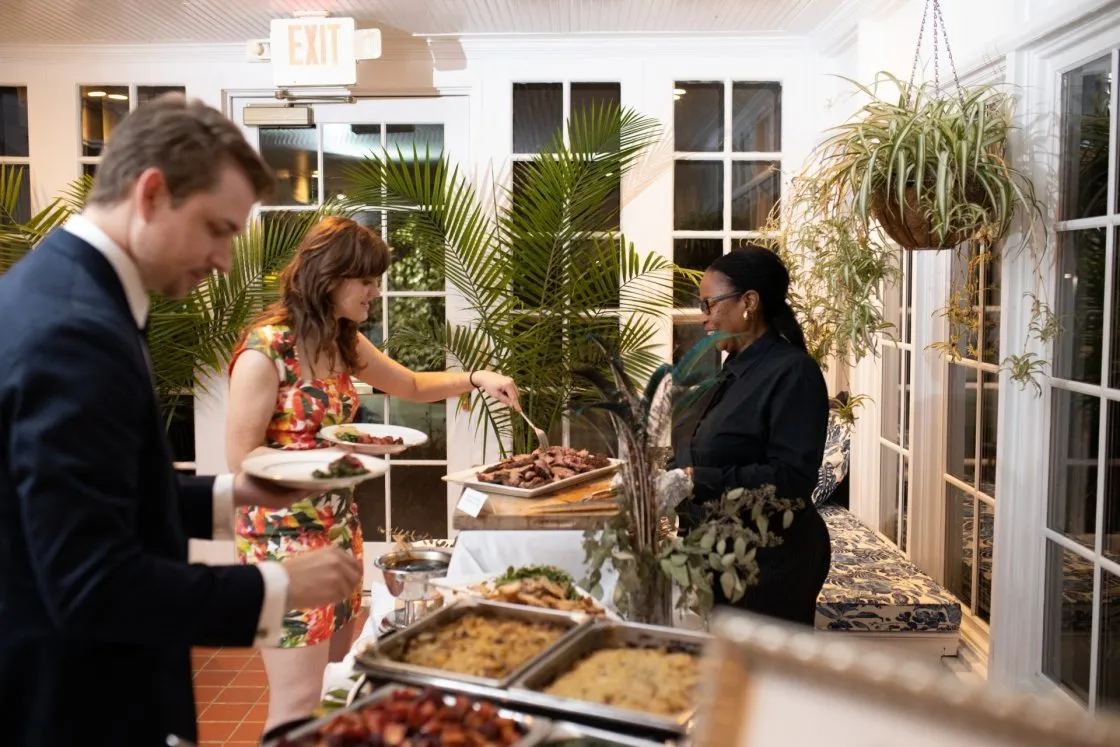
Sophisticated buffet service featuring interactive chef stations and elegant displays
Family-Style Dining
Family-style service bridges the gap between formal plated dinners and casual buffets, creating a communal dining experience that encourages interaction while maintaining the structure of seated meal service. Large platters of food are brought to each table for guests to serve themselves and pass among their tablemates, fostering conversation and connection through the shared act of breaking bread together.
This approach works particularly well for couples who value community and want to recreate the warmth of family dinners within their celebration. The passing of platters naturally facilitates conversation among guests who may not know each other, creating organic introductions and shared experiences. For weddings where building connections between different friend groups and family members is a priority, family-style service can help break the ice.
Menu planning for family-style service requires careful consideration of how dishes will function in this format. Opt for foods that are easily portioned by guests, maintain their temperature and presentation quality while being passed, and aren't overly messy or complicated to serve. Avoid very saucy dishes that might drip during passing or items requiring complex carving at the table.
Table design becomes particularly important with family-style service, as you'll need to accommodate both place settings and food platters simultaneously. Work with your rental company and florist to design table layouts that allow adequate space for shared plates while maintaining your desired aesthetic. Low, spread-out centerpieces work better than tall, narrow arrangements that might need to be moved during service.
From a budget perspective, family-style service typically costs less than plated service in terms of staffing but may incur higher food costs due to the need to prepare extra portions to ensure all tables have ample food. The visual abundance of platters heaped with food creates a sense of generosity and plenty that many couples value as part of their hospitality philosophy.
Dietary Considerations and Inclusive Menu Planning
Creating an inclusive wedding menu that accommodates various dietary needs has become a standard expectation rather than an exception. With increasing awareness of food allergies, intolerances, and ethical dining choices, thoughtful consideration of these needs demonstrates care for your guests' wellbeing and ensures everyone can fully participate in your celebration.
The key to successful inclusive menu planning is addressing dietary considerations as an integral part of your initial menu development rather than as an afterthought. When these needs are considered from the beginning, solutions can be elegant and cohesive rather than feeling like last-minute substitutions. Work with caterers who have experience and creativity in addressing dietary restrictions while maintaining culinary excellence.
Communication about dietary options should be clear but discreet. Collect information through your RSVP system, and ensure your catering team has a reliable method for identifying which guests require specific accommodations. For buffet or station service, clear, elegant labeling helps guests navigate options independently, while for plated service, servers should be thoroughly briefed on meal components.
Beyond accommodating specific restrictions, consider how your overall menu design might naturally include options for different needs. Many contemporary wedding menus incorporate plant-forward dishes that appeal to all guests while happening to be appropriate for vegetarians and vegans. This integrated approach feels more inclusive than segregating 'special meals' from the main offerings.
Common Dietary Restrictions and Solutions
Vegetarian and vegan options have evolved far beyond basic pasta primavera or grilled vegetables. Today's plant-based wedding cuisine includes sophisticated options like wild mushroom Wellington with truffle essence, compressed watermelon 'steaks' with balsamic reduction, or ancient grain risotto with seasonal vegetables. These dishes are designed to satisfy and impress all guests, not just those following plant-based diets.
Gluten-free needs can be addressed through thoughtfully developed alternatives rather than simple omissions. For example, rather than serving a burger without a bun, consider gluten-free brioche buns that allow these guests the complete experience. Many global cuisines naturally feature gluten-free options—like rice-based Asian dishes or naturally corn-based Mexican preparations—that can be highlighted without modification.
Dairy allergies and lactose intolerance require attention to hidden ingredients in many dishes. Modern plant-based alternatives like cashew creams, coconut-based products, and nutritional yeast can provide richness and depth in dairy-free preparations. These alternatives have improved dramatically in recent years, allowing skilled chefs to create dairy-free dishes that don't feel like compromises.
Nut allergies require particular vigilance due to their potentially serious consequences. Beyond avoiding obvious nut-containing dishes, your catering team should be aware of cross-contamination risks and hidden sources of nuts in prepared ingredients. Clear communication with the kitchen about the severity of specific guests' allergies ensures appropriate precautions are taken throughout preparation.
Religious dietary restrictions, such as kosher or halal requirements, often need specialized preparation areas and ingredients. If you have several guests with these needs, consider working with specialty caterers who can provide appropriate meals, or discuss with your primary caterer whether they have experience and certification for these preparations. These considerations show respect for your guests' religious practices and allow them to celebrate fully without compromise.
Creating a Unified Dining Experience
One of the challenges in accommodating diverse dietary needs is maintaining a cohesive dining experience where no guest feels singled out or served a lesser version of the meal. Strategic menu design can address this concern by creating parallel experiences—dishes that share presentation style, accompaniments, and flavor profiles while varying the central protein or key ingredients to meet different needs.
Consider developing menu 'trios' where similar preparation techniques are applied to different proteins—perhaps herb-roasted chicken, grilled halibut, and roasted portobello mushrooms—all served with the same seasonal vegetables and starch. This approach allows the kitchen to work efficiently while ensuring all guests receive a thoughtfully designed plate regardless of their dietary requirements.
Buffet and station service can be designed with inclusivity in mind by ensuring that options for different dietary needs are integrated throughout rather than segregated to a 'special section.' When vegetarian, gluten-free, and other options are presented alongside standard offerings with clear but discrete labeling, guests with restrictions can navigate the selections with dignity and without drawing attention to their needs.
Family-style service presents unique challenges for dietary restrictions but can be managed through thoughtful planning. Consider serving some dishes that naturally meet multiple dietary needs, supplemented by a few specialized options for specific requirements. Servers can quietly deliver alternative dishes directly to guests with known restrictions while the standard offerings are placed for sharing.
Remember that the goal is for all guests to feel equally valued through their dining experience. When accommodation for dietary needs is approached as an opportunity for culinary creativity rather than an inconvenience, it often results in menu innovations that enhance the overall wedding feast for everyone present. The most successful inclusive menus are those where many guests don't even realize they're enjoying dishes designed to meet specific dietary requirements.
Seasonal Wedding Food Ideas
Embracing seasonality in your wedding menu offers multiple benefits, from superior flavor and freshness to potential cost savings and environmental sustainability. When ingredients are sourced at the peak of their natural growing season, they require less intervention to taste wonderful and often cost less than out-of-season alternatives that must be shipped from distant locations.
Beyond practical considerations, seasonal menus create a natural harmony with your wedding date and setting. A summer wedding featuring bright citrus, heirloom tomatoes, and fresh berries feels appropriately refreshing, while an autumn celebration showcasing root vegetables, mushrooms, and warming spices creates a sense of coziness and abundance that complements the season.
Working with seasonal ingredients also allows local producers to shine, creating an authentic sense of place that connects your celebration to its location. Whether you're hosting a destination wedding or celebrating in your hometown, locally grown seasonal produce tells the story of the land and the community where you're joining your lives together.
Each season offers unique opportunities for creative menu development, with distinctive ingredients and preparation styles that feel intuitively right for that time of year. By embracing these natural rhythms, you create a dining experience that feels intentional and connected to something larger than a single day's celebration.
Summer Wedding Feasts
Summer wedding menus capture the season's abundance and vibrant energy with ingredients at the peak of ripeness and flavor. Heirloom tomatoes in every color, sweet corn, stone fruits, and fragrant herbs create a palette of intense flavors and colors that need little embellishment. The bounty of summer allows for menus that feel generous and exuberant, much like the season itself.
For outdoor summer weddings, consider how the heat might affect guest comfort and food stability. Lighter fare served at room temperature or chilled options can be more appealing than heavy, hot dishes. A chilled corn and basil soup, poached salmon with herb sauce, or citrus-marinated grilled chicken offer substantive options that won't feel oppressive in warm weather.
Summer cocktail hours benefit from refreshing, thirst-quenching options alongside traditional alcoholic offerings. Consider fruit-infused water stations, white sangria with summer fruits, or classic mojitos with fresh mint. These beverages help guests stay hydrated and comfortable while still participating in the celebratory atmosphere.
Desserts for summer weddings can showcase the incredible fruits of the season. Rather than heavy buttercream cakes, consider lighter options like naked cakes with mascarpone and fresh berries, individual pavlovas with stone fruit compote, or even elevated ice cream or sorbet stations featuring seasonal flavors. These refreshing finishes complement the weather and seasonal ingredients.
One signature of summer weddings is the opportunity for outdoor cooking elements that become part of the entertainment. Wood-fired pizza ovens, open-flame grilling stations, or traditional barbecue offerings can create interactive experiences that engage multiple senses and create a relaxed, festive atmosphere perfect for warm-weather celebrations.
Autumn Harvest Celebrations
Autumn wedding menus embrace the transition to heartier, more complex flavors as temperatures cool and the harvest reaches its peak. Root vegetables, winter squashes, mushrooms, apples, and pears create a palette of earthy, sweet, and savory notes that can be combined in countless satisfying ways. The natural color scheme of autumn—deep reds, burnt oranges, rich browns—creates visually stunning presentations.
Main courses for fall weddings can incorporate slow-cooking methods that develop depth and richness. Red wine-braised short ribs, cider-brined pork loin with roasted apples, or butternut squash ravioli with brown butter and sage offer comforting, sophisticated options perfect for the season. These heartier preparations satisfy after a day in the crisp autumn air.
Signature cocktails for autumn weddings often incorporate warm spices, apple cider, bourbon, or pear nectar. Consider hot apple cider stations (with optional spirits for spiking), maple old-fashioneds, or spiced pear sparklers. These seasonal beverages create a sense of coziness and comfort that complements the overall autumn experience.
Dessert options for fall weddings might include warm apple crisps served with cinnamon ice cream, pumpkin cheesecake with pecan praline, or spiced carrot cake with cream cheese frosting. The warming spices of autumn—cinnamon, nutmeg, clove, ginger—feature prominently in these comforting sweets and connect to nostalgic memories of harvest celebrations.
Table settings for autumn weddings can incorporate the bounty of the season, with arrangements that might include small pumpkins, pomegranates, grape clusters, or apple branches alongside floral elements. These natural decorative touches reinforce the seasonal theme and create a harmonious connection between the visual environment and the menu selections.
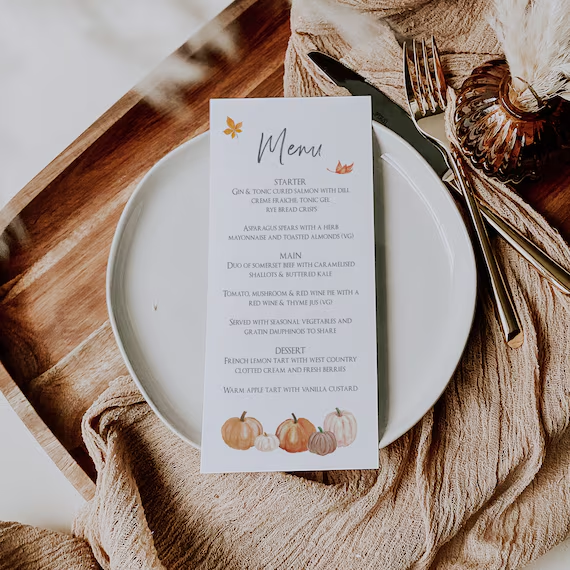
Seasonal menu showcasing the finest ingredients available during the wedding season
Winter Wedding Comfort Foods
Winter wedding menus embrace richness and comfort, offering guests warming dishes perfect for the coldest season. This is the time for luxurious ingredients and preparations that might feel too heavy in warmer months—think truffle-infused dishes, rich braises, and decadent chocolate desserts. The limited availability of fresh produce in winter is balanced by the abundance of preserved, aged, and imported luxury ingredients.
For cocktail hour, consider stations that offer physical and internal warmth. Cheese fondue with artisanal bread and accompaniments, miniature mugs of butternut squash soup, or bite-sized portions of truffle mac and cheese provide satisfying options that take the chill off. For beverages, hot chocolate bars (with options for adults), warm mulled wine, or hot toddies create cozy experiences perfect for the season.
Main courses for winter weddings often feature slow-cooked meats that develop deep flavor. Beef Wellington with mushroom duxelles, osso buco with gremolata, or duck confit with cherry reduction offer rich, complex flavors appropriate for special occasions. For vegetarian options, consider wild mushroom strudel with truffle cream or butternut squash risotto with crispy sage and brown butter.
Desserts for winter weddings often feature chocolate prominently, with options like molten chocolate cake, dark chocolate tarts with salted caramel, or chocolate bread pudding with crème anglaise. These indulgent options feel appropriately festive and satisfying during the coldest months, especially when paired with coffee service or dessert wines.
The beverage program for winter weddings might include a dedicated after-dinner drink station featuring ports, sherries, brandies, or dessert wines. These warming sips provide a pleasant conclusion to the meal and create natural gathering points where guests can linger and converse in a relaxed, comfortable atmosphere before joining the dancing.
Budget-Friendly Food Options That Impress
Creating a memorable wedding menu doesn't necessarily require an unlimited budget. With creative planning and strategic choices, couples can serve impressive, delicious food while managing costs effectively. The key is understanding where to invest for maximum impact and where to make thoughtful compromises that guests won't notice or mind.
Working with caterers who value transparency and problem-solving can make a significant difference in your food budget planning. Rather than simply saying 'no' to options above your price range, skilled catering professionals can suggest creative alternatives that maintain the spirit of your vision while fitting within your financial parameters. This collaborative approach ensures you get the most value for your investment.
Timing can also impact your food and beverage costs significantly. Consider a brunch or lunch reception, which typically costs less than dinner while still offering ample opportunity for celebration. Alternatively, an afternoon reception with heavy hors d'oeuvres rather than a full meal can create a festive atmosphere without the expense of a multi-course dinner.
Remember that your guests will likely remember the overall experience—the atmosphere, the company, the celebration of your union—more than specific menu details. Prioritizing quality and thoughtful presentation within your means creates a more positive impression than stretching beyond your budget for luxury ingredients that create financial stress.
Creative Appetizers That Stretch Your Dollar
Appetizers offer excellent opportunities for cost-effective yet impressive presentations. Consider vegetable-forward options like seasonal crudités displayed dramatically with house-made dips, or bruschetta with various toppings that transform simple bread into elevated bites. These plant-based options typically cost less than meat-centric alternatives while offering vibrant flavors and colors.
Strategic use of high-impact, lower-cost ingredients can create standout appetizers without breaking the bank. Items like olives, pickled vegetables, and roasted nuts can be presented beautifully and provide satisfying flavor. Consider a Mediterranean display with hummus, marinated olives, and flatbread, which offers abundant options at a reasonable price point.
For passed hors d'oeuvres, focus on items that deliver big flavor in small packages. Stuffed mushrooms, fried risotto balls with seasonal herbs, or potato croquettes with aioli offer satisfying bites that showcase culinary skill rather than expensive ingredients. These labor-intensive but ingredient-efficient options often impress guests more than simpler items with costly components.
Consider serving one or two signature bite-sized items rather than an extensive variety. This focused approach allows your caterer to prepare larger quantities of fewer items, potentially reducing labor costs while still providing an abundant impression. When these items are thoughtfully presented and replenished frequently, guests perceive abundance even with limited variety.
If your heart is set on including some luxury items like shrimp or smoked salmon, consider offering them at a dedicated station rather than passed throughout cocktail hour. This approach creates a focal point of luxury while allowing you to control portions and supplement with more budget-friendly options in other areas of your reception.
Economical Entrée Options with Gourmet Appeal
For budget-conscious main courses, consider elevated presentations of more affordable proteins. Chicken breasts become special when butterflied and stuffed with herb mousse, while less expensive cuts of beef like flank steak or sirloin can shine with proper marinades and cooking techniques. These approachable options feel familiar and satisfying to guests while staying within reasonable cost parameters.
Served family-style, these entrées can create an abundant impression while controlling portions. Large platters of sliced stuffed chicken breast or herb-crusted pork loin passed among tables create a communal experience while allowing your caterer to predict exactly how much to prepare, minimizing costly waste.
Consider entrées that feature multiple components where less expensive elements provide volume and substance while smaller amounts of premium ingredients add luxury touches. A risotto with seasonal vegetables might include just enough seared scallops to provide elegance without requiring a full seafood portion per person. This balanced approach creates memorable flavors without premium pricing.
Pasta dishes offer exceptional value when thoughtfully presented. Rather than basic baked ziti, consider handmade ravioli with seasonal fillings, pappardelle with braised short rib ragu, or orecchiette with sausage and broccoli rabe. These options showcase culinary skill and abundant flavor while leveraging affordable base ingredients and smaller amounts of protein.
When planning budget-conscious menus, consider regional cuisines that traditionally transform humble ingredients into celebrated dishes. Southern shrimp and grits, Texas-style smoked brisket, New England clam bakes, or Louisiana jambalaya all represent honored culinary traditions that don't require luxury ingredients to feel special and appropriate for celebration.
Dessert Strategies That Save Without Sacrificing
Wedding cakes represent a significant expense in many reception budgets, but creative alternatives can provide memorable sweet endings at a fraction of the cost. Consider serving a small ceremonial cake for cutting and photographs, supplemented with sheet cakes of the same flavor served from the kitchen. This approach maintains the tradition while dramatically reducing the per-slice cost.
Dessert bars featuring house-made cookies, brownies, and miniature pastries offer variety and abundance at approachable price points. These smaller portions allow guests to sample multiple items and cater to different preferences without the expense of individual plated desserts. Simple, rustic presentations on wooden boards or vintage cake stands can create visual impact without additional expense.
Seasonal fruit-based desserts often cost less than elaborate pastries while offering fresh, bright flavors that guests appreciate after a substantial meal. Consider summer berry shortcakes, fall apple crisps, or winter citrus tarts, depending on your wedding season. These fruit-forward options feel lightened and refreshing rather than like budget-conscious compromises.
For couples who enjoy baking, dessert can become a personal element of the reception. Family recipe cookies displayed with story cards, pies made from grandparents' recipes, or cultural desserts that reflect heritage all add meaningful touches without professional pastry chef pricing. These homemade elements create conversation and connection among guests through shared storytelling.
If professional desserts are important to you, consider working with small, independent bakeries or culinary school programs rather than specialized wedding cake designers. These alternatives often offer excellent quality at lower price points as they build their portfolios and client bases. Be open to their suggestions for designs and flavors that they can execute exceptionally within your budget.
Final Thoughts: Creating Your Perfect Wedding Menu
Planning the perfect wedding menu involves creativity, attention to detail, and a clear vision of the experience you want to create for your guests. By incorporating creative wedding food ideas such as grazing tables, unique appetizers, and elegant main courses, you can craft a dining experience that reflects your personality as a couple while creating lasting memories for everyone in attendance.
Throughout this guide, we've explored numerous approaches to wedding cuisine, from traditional plated service to interactive food stations, seasonal inspirations to budget-conscious strategies. The wealth of options available allows you to customize every aspect of your wedding menu to align with your vision, venue, and values.
As you finalize your wedding food plans, remember that the most successful menus balance several key elements: visual appeal, flavor harmony, practical service considerations, and personal significance. When these elements work together cohesively, your wedding meal becomes more than just sustenance—it becomes an integral part of your celebration story.
Consider working with catering professionals who share your vision and can translate your ideas into executable plans. Their expertise with wedding logistics, ingredient seasonality, and service requirements proves invaluable in bringing your culinary dreams to life while navigating practical constraints.
Above all, let your wedding menu be a reflection of you—your shared history, your cultural heritage, your favorite flavors, and the future you're building together. When approached thoughtfully, your wedding food becomes another meaningful way to share your story with the people you love most as you celebrate this significant milestone. For more specialized menu planning guidance, explore our recipe finder tool to discover dishes that might inspire your own wedding menu selections.
Frequently Asked Questions
Sources & References
- Wedding Food Trends 2025 2025-01-15
- The Art of Grazing Tables 2024-12-10
- Seasonal Menu Planning for Weddings 2025-02-01